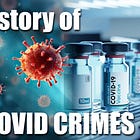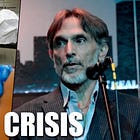Do Viruses Exist?
Discussing the middle ground between germ and terrain theories while exposing fraudulent practices behind COVID testing
Sanitation, nutrition, and hygiene reduced disease mortality long before vaccines, while reliance on PCR testing distorted the reality of COVID-19. In response to this PCR deception, some have argued that viruses do not exist at all, yet clear structural and symptomatic patterns strongly suggest otherwise. Both terrain theory and virology represent essential perspectives that must be integrated into a more holistic understanding of the human body and how we can strengthen the natural immune system for lasting, resilient health.
Acknowledgements & How to Get Involved
A big thank you to the Pembroke Freedom Group for organizing this important gathering. If you live in the Pembroke region, be sure not to miss future events. To stay informed, you can request a free subscription to the Pembroke Freedom Group’s newsletter by emailing pomercat@yahoo.com.
Special thanks also to Vlad Tepes for recording this video, the Rair Foundation USA for their support, and Finnigan’s Bar and Grill in Pembroke for generously hosting the event.
Help us in driving forward solution-oriented research, raising awareness of the new wave of pathology, empowering the public with health sovereignty, and fostering meaningful change through dedicated grassroots efforts, by supporting our mission today.
Germs vs. Terrain: The Debate Rekindled
The COVID era reignited arguments over whether disease is caused by germs or by the body’s “terrain.” Some claimed viruses don’t exist at all, attributing illness solely to poor immune health. Yet distinct structural and symptomatic trends strongly suggest otherwise.
Under a microscope, herpes, adenoviruses, and coronaviruses each show characteristic geometry that makes them identifiable. The illnesses they cause also follow consistent clinical patterns: chickenpox does not resemble measles, and COVID produced its own recognizable sequence of cough, fever, and fatigue. These recurring features are difficult to dismiss as random byproducts of a weakened body.
Even so, the strength of an individual’s immune system—shaped by nutrition, rest, and stress—often determines whether illness is mild or severe. The most plausible view is not that either germ theory or terrain theory alone is true, but that both address parts of a larger picture. This balance becomes even clearer when looking at history, where improvements in hygiene and living conditions dramatically improved health.
Hygiene, Not Vaccines, Reduced Mortality
Deaths from infectious disease plummeted long before modern vaccination campaigns. Between 1900 and 1950, measles deaths in the U.S. dropped by over 95%, thanks largely to plumbing, refrigeration, cleaner food, and improved hygiene. When the measles vaccine was introduced in the 1960s, mortality had already collapsed. Suspiciously, deaths spiked slightly after the rollout before declining again. This shows that public health improvements, not pharmaceutical products, were the major factor in saving lives.
The PCR Problem and Manufactured Fear
COVID-19 cemented the misuse of PCR testing. Instead of relying on clinical diagnosis—evaluating a broad spectrum of factors such as symptoms, patient history, and physical examination—governments imposed a testing regime detached from medical reality. Laboratories amplified fragments of genetic material through excessive cycle counts, often exceeding 43 (for reference, 25 is already too high). In Ghana, even a papaya, a quail, and a goat tested “positive” when the nation’s president personally submitted samples. Irregular PCR practices fueled public panic, allowed sweeping policy overreach, and produced wildly distorted statistics.
Redefining “Efficacy” in COVID-19 Trials
Further, pharmaceutical companies exploited this flawed testing method to claim their products were effective. In Pfizer and Moderna’s trials, the “vaccinated” group actually suffered more illness and death, yet was reported to have fewer PCR-confirmed COVID cases. The likely explanation is that fewer PCR cycles were run for the “vaccinated” group, while the “unvaccinated” group was tested with excessive cycles, virtually guaranteeing positives. This manipulation created the illusion of protection. Instead of reporting the 0.7% absolute risk reduction—already a misleading figure—they reframed it as a 95% “relative risk reduction.” Through this statistical sleight of hand, their products appeared far more effective than they actually were.










I have a great respect and admiration for you Dr Trozzi, and also Dr Mike Yeadon and Dr's Sam and Mark Bailey . I'm happy to not be sure about viruses , I'll keep on listening to all of you . Thank you so much for your commitment to truth .
there is this article from health impact news-German Supreme Court Upholds Biologist’s Claim that Measles Virus Does Not Exist-and i don't recall anybody isolating the covid19 'virus'? but then again i have a runny nose and sore throat this morning from cuddling my granddaughter this weekend. just saying....